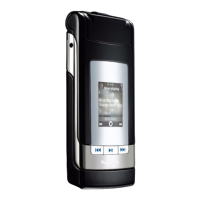
Do you have a question about the Nokia N76 and is the answer not in the manual?
| Panel type | TFT |
|---|---|
| Display diagonal | 2.4 \ |
| Display resolution | 240 x 320 pixels |
| Display number of colors | 16.78 million colors |
| Internal memory | 26 MB |
| Rear camera type | Single camera |
| Rear camera resolution | 1600 x 1200 pixels |
| Multimedia Messaging Service (MMS) | Multimedia Messaging Service (MMS) is a standard way to send messages that include multimedia content to and from a mobile phone over a cellular network |
| Ringer type | Polyphonic |
| Form factor | Clamshell |
| Product color | Red |
| Talk time (2G) | 2.5 h |
| Battery capacity | 700 mAh |
| Standby time (2G) | 200 h |
| 2G standards | EDGE, GPRS |
| Bluetooth version | 2.0+EDR |
| Personal info management (PIM) | Alarm clock, Calendar |
| Depth | 52 mm |
|---|---|
| Width | 106.5 mm |
| Height | 13.7 mm |
| Weight | 115 g |
Configure general device settings like language, standby, and display.
Device operation modes: Fold closed (cover display) and Fold open (main display).
Using the main display for full device access and menu navigation.
Overview of device keys and navigation methods for operating the phone.
Explains Menu, Scroll, Multimedia, Edit, Capture, Quick Cover, and Volume keys.
Supports various audio file formats for playback and library management.
Instructions for playing music with the fold open or closed.
Navigating music library, creating playlists, and managing songs.
Transferring music files from PC or other devices via USB or Bluetooth.
Using FM radio with visual content and station management.
Playing video clips and streaming media files over the air.
Instructions for capturing still images with the main and secondary cameras.
Explains viewfinder indicators, active toolbar, scenes, flash, and color settings.
Instructions for recording video clips using cover or main display.
Setting and customizing ringtones, alerts, and profiles for events and contacts.
Managing bookmarks, browsing web pages, and using text search.
Connecting to compatible devices wirelessly using Bluetooth technology.
Creating and sending text, multimedia, and e-mail messages.
Making and receiving voice calls, adjusting volume, and using contacts.
Making and receiving video calls, including video sharing.
Saving, editing, copying contacts, SIM directory, and default numbers.
Installing, removing, and managing applications and software on the device.
Configuring display, personalization, date/time, and general device options.
Managing PIN/lock codes, certificates, factory settings, and device security.
Configuring call settings, divert, barring, network mode, and caller ID.
Managing network modes, connections, and access points.
Guidelines for charging, discharging, and handling the device battery.
Guidelines for using the device near medical devices and implanted medical devices.
Safety precautions for areas with potentially explosive atmospheres.
Instructions for making emergency calls and providing necessary information.